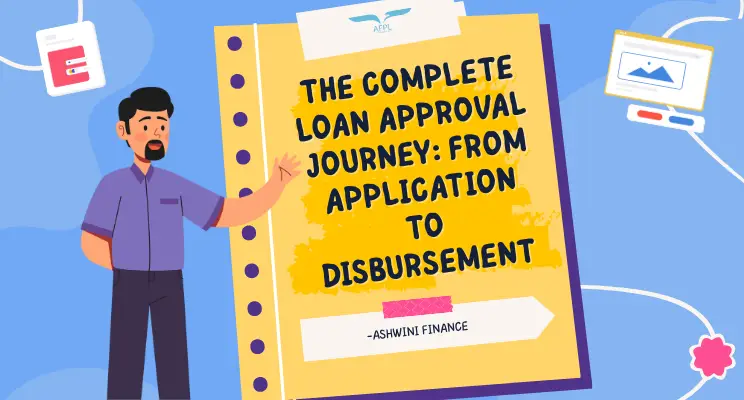The Complete Loan Approval Journey: From Application to Disbursement
Getting a loan can feel like navigating a maze, but it doesn’t have to be confusing. Let’s break down the entire journey into simple steps so you know exactly what to expect. Step 1: Application Submission This is where it all begins. You fill out a loan application form with basic details like your name, income, employment, and how much money you need. Most banks now let you do this online, which takes about 15-30 minutes. What you’ll need: ID proof, address proof, income documents (salary slips or bank statements), and details about what you’re buying (if it’s a home or car loan). Step 2: Initial Screening The bank does a quick check to see if you meet their basic requirements. They look at your age, income level, employment status, and credit score. This usually happens within 24-48 hours. Pro tip: Your credit score matters a lot here. A score above 750 significantly improves your chances. Step 3: Document Verification If you pass the initial screening, the bank asks for detailed documents. They want to verify everything you’ve claimed – your income, your employment, your address, and your identity. Common documents include: Last 3-6 months’ salary slips 6 months’ bank statements Form 16 or IT returns Property documents (for home loans) Business proof (for self-employed applicants) Note: The list of documents provided is not exhaustive. Depending on your profile and specific case, institutions may request additional documents. This stage can take 3-7 days depending on how quickly you submit complete documents. Step 4: Credit Appraisal Here’s where the bank does the heavy lifting. They analyze your financial health in detail: Income vs. Expenses: Can you afford the Equated Monthly Installment (EMI)? Credit History: Have you repaid past loans on time? Debt-to-Income Ratio: How much of your income already goes to other loans? Stability: How long have you been in your current job? The bank uses all this information to decide how much risk you pose as a borrower. This typically takes 5-10 days. Step 5: Property Valuation (For Secured Loans) If you’re taking a home or car loan, the bank sends someone to check the property or vehicle. They want to make sure it’s worth the amount you’re borrowing. For home loans, a technical expert visits the property to check its legal status, construction quality, and market value. This can take 7-15 days. Step 6: Legal Verification (For Home Loans) The bank’s legal team verifies all property documents to ensure there are no disputes, the seller has clear ownership, and all approvals are in place. This is crucial because the property becomes the bank’s security until you repay the loan. This step usually takes 10-15 days and is often the longest part of the process. Step 7: Loan Approval Once everything checks out, you get the magical “loan approved” message! The bank sends you a sanction letter stating: Approved loan amount Interest rate Tenure (repayment period) EMI amount Terms and conditions Important: Read this document carefully. This is your contract with the bank. Step 8: Signing the Agreement You visit the bank to sign the loan agreement and other legal documents. You’ll also need to: Pay processing fees (if not paid already) Submit post-dated cheques or set up auto-debit for EMIs Arrange for a guarantor (if required) Sign property mortgage documents (for home loans) Step 9: Insurance Most banks require you to take insurance to protect the loan. For home loans, you’ll need property insurance and often life insurance too. For car loans, comprehensive vehicle insurance is mandatory. Step 10: Disbursement Finally, the money is released! But the disbursement method varies: For Home Loans: Under-construction property: Money is released in stages as construction progresses Ready property: Full amount is transferred to the seller after registration For Personal/Car Loans: Amount is transferred directly to your account or the seller For Business Loans: May be released in parts based on your business needs After Disbursement Your loan journey doesn’t end here. Now begins your repayment journey: EMIs start, usually from the next month You receive a loan account statement You can track your loan online Keep all documents safe for future reference How Long Does the Entire Process Take? Personal Loans: 2-7 days (fastest) Car Loans: 7-15 days Home Loans: 3-6 weeks (or longer for under-construction properties) Business Loans: 2-8 weeks depending on complexity Tips for a Smooth Journey Keep documents ready: Having everything organized speeds up the process Maintain a good credit score: This is your financial reputation Be honest: Don’t hide information; it will come out during verification Respond quickly: Answer bank queries promptly to avoid delays Compare options: Check rates and terms from multiple lenders before applying Common Reasons for Rejection Low credit score (below 650) Insufficient income for the requested loan amount Too many existing loans Irregular income or job changes Incomplete or fake documents Legal issues with the property The Bottom Line The loan approval process has multiple steps for good reason – the bank wants to ensure you can repay the loan, and you want to ensure you’re getting a fair deal. While it might seem lengthy, each step protects both you and the lender. Understanding this journey helps you prepare better, avoid surprises, and increase your chances of approval. So gather your documents, check your credit score, and start your loan journey with confidence! Looking for Hassle-Free Loan Solutions? If you’re ready to begin your loan journey with a trusted partner, Ashwini Finance is here to help. As an RBI-registered NBFC, we understand that getting a loan should be straightforward, not stressful. Why Choose Ashwini Finance? ✅ Trusted NBFC – RBI registered and compliant ✅ Quick Approvals – Fast processing with minimal delays ✅ Expert Guidance – Professional support at every step ✅ Customer Focused – Your financial goals are our priority ✅ Minimal Documents – Simple, hassle-free documentation ✅ Secure Process – Your information is safe with us Our Loan Services Include: New Car Loan Two Wheeler Loan Pre-Owned Car Loan Medical Equipment
The Complete Loan Approval Journey: From Application to Disbursement Read More »


